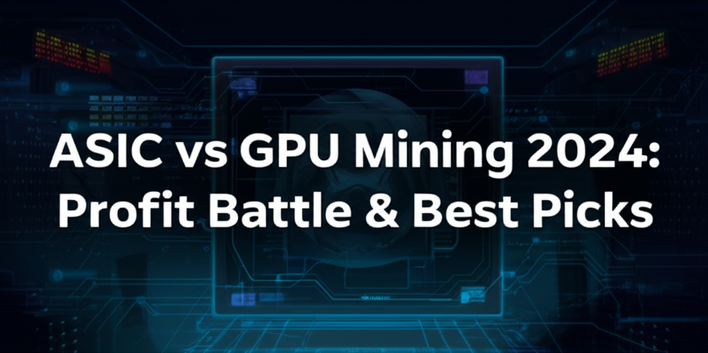The landscape of cryptocurrency mining is ever-evolving. In 2024, miners face a critical decision: invest in powerful, specialized ASIC machines or versatile, programmable GPU rigs? This guide breaks down the pros, cons, profitability, and optimal use cases for each, helping you navigate the complexities of modern crypto mining.
As the crypto market matures and network difficulties climb, the choice of mining hardware becomes paramount to profitability. This comprehensive comparison will arm you with the knowledge to make an informed decision, considering factors like upfront cost, power efficiency, versatility, and long-term viability.
ASIC Mining: The Specialized Powerhouse
Application-Specific Integrated Circuits (ASICs) are purpose-built machines designed to perform a single function: mine a specific cryptocurrency algorithm with maximum efficiency. Think of them as high-performance sports cars tuned for a single race track.
Pros of ASIC Mining
- Unmatched Hash Rate: For the algorithms they are designed for (e.g., SHA-256 for Bitcoin), ASICs deliver significantly higher hash rates than GPUs, often by several orders of magnitude.
- Superior Energy Efficiency: Per unit of hashing power, ASICs consume less electricity, translating to lower operational costs and higher profits, especially for large-scale operations.
- Plug-and-Play Simplicity: Modern ASICs are generally easier to set up than GPU rigs, often requiring little more than power and an internet connection.
- Focused Optimization: Their specialized nature means they are engineered from the ground up for mining, leaving no room for general computing overhead.
Cons of ASIC Mining
- Lack of Versatility: This is their biggest drawback. An ASIC designed for SHA-256 cannot mine an Ethereum-based coin (Ethash) or a Ravencoin (KawPow) coin. If the algorithm becomes unprofitable or a coin switches to Proof of Stake (like Ethereum did), the ASIC becomes a very expensive paperweight.
- High Upfront Cost: High-end ASICs can cost thousands, even tens of thousands, of dollars, making the barrier to entry quite high.
- Rapid Obsolescence: As new, more powerful ASICs are released, older models quickly become less profitable and can be rendered obsolete within a year or two due to increased network difficulty.
- Noise and Heat: ASICs are notoriously loud and produce significant heat, requiring dedicated cooling and sound insulation solutions.
- Centralization Concerns: The high cost and specialized nature of ASICs contribute to mining centralization, as only well-funded entities or large farms can afford to operate them at scale.
Best Use Cases for ASIC Miners
ASICs are the undisputed champions for mining well-established, high-market-cap cryptocurrencies with dedicated algorithms, such as:
- Bitcoin (BTC): Using the SHA-256 algorithm.
- Litecoin (LTC): Using the Scrypt algorithm.
- Dogecoin (DOGE): Also using Scrypt, often mined in conjunction with Litecoin.
- Bitcoin Cash (BCH): Using SHA-256.
If your goal is to exclusively mine one of these major coins at scale, and you have access to cheap electricity, ASICs offer the highest potential for return on investment.
GPU Mining: The Versatile Workhorse
Graphics Processing Units (GPUs), the same powerful components found in gaming PCs, were once the primary hardware for mining many cryptocurrencies, most notably Ethereum. Their flexibility allows them to crunch various algorithms.
Pros of GPU Mining
- Exceptional Versatility: GPUs can mine a wide array of cryptocurrencies that utilize different algorithms. If one coin becomes unprofitable, you can easily switch to another. This adaptability is crucial in a volatile market.
- Higher Resale Value: Unlike specialized ASICs, GPUs retain significant resale value because they have diverse applications beyond crypto mining, such as gaming, video editing, AI workloads, and scientific computing.
- Lower Entry Cost (Potentially): While high-end GPUs can be expensive, you can start with fewer cards or even repurpose existing gaming hardware, making the initial investment more flexible.
- Easier to Source: GPUs are generally more readily available from consumer electronics retailers compared to specialized ASICs, which often require ordering directly from manufacturers.
- Decentralization: GPU mining allows more individuals to participate, fostering a more decentralized network compared to ASIC-dominated coins.
Cons of GPU Mining
- Lower Hash Rate (for ASIC-dominated coins): For algorithms like SHA-256, GPUs cannot compete with the hash rate or efficiency of ASICs.
- Higher Power Consumption (per hash): Relative to ASICs, GPUs are less energy-efficient for the algorithms ASICs specialize in, though they can be very efficient for others. This can lead to higher electricity bills.
- More Complex Setup: Building and optimizing a GPU mining rig requires more technical knowledge, including configuring motherboards, risers, power supplies, and operating system optimizations.
- Noise and Heat: Similar to ASICs, multiple GPUs running at full tilt generate considerable noise and heat, necessitating proper ventilation.
- Impact of The Merge: Ethereum’s transition to Proof of Stake significantly impacted GPU mining profitability, demonstrating the risk of algorithm or consensus mechanism changes.
Best Use Cases for GPU Miners
GPU mining thrives on cryptocurrencies that are either resistant to ASICs or have not yet seen widespread ASIC development:
- Ravencoin (RVN): Uses the KawPow algorithm.
- Ergo (ERG): Uses the Autolykos algorithm.
- Monero (XMR): Primarily CPU-mined with RandomX, but some GPUs can also contribute.
- Flux (FLUX): Uses the ZelHash algorithm.
- New or Emerging Altcoins: GPUs are often the first choice for mining new Proof of Work coins before ASICs are developed for their specific algorithms.
If you prioritize flexibility, want to diversify your mining efforts, or foresee potential resale opportunities, GPUs are an excellent choice.
Key Comparison Metrics: ASIC vs. GPU in 2024
1. Profitability & ROI
This is often the deciding factor. Calculating profitability involves several variables:
- Hardware Cost: Initial investment in ASICs or GPUs.
- Hash Rate: How much computational power your hardware provides.
- Power Consumption: The electricity used by your hardware (and peripherals).
- Electricity Cost: Your local rate per kWh. This is crucial; high electricity costs can render any mining unprofitable.
- Coin Price & Network Difficulty: The value of the mined cryptocurrency and how hard it is to find a block.
ASICs typically offer higher gross profits for their specialized coins due to superior efficiency. However, their high upfront cost and rapid depreciation can extend their ROI period.
GPUs might offer lower profits per unit for ASIC-dominated coins but can achieve a faster ROI on less competitive altcoins, especially if you can switch between profitable options.
Tools like WhatToMine are indispensable for real-time profitability calculations.
2. Flexibility & Future-Proofing
GPUs win hands down here. Their ability to mine various algorithms makes them adaptable to market shifts. If a coin becomes unprofitable or transitions to PoS, you can pivot to another. This flexibility also extends to their utility beyond mining; they can be repurposed for gaming, AI, or rendering, safeguarding your investment.
ASICs are rigid. Their “future-proofing” is limited to the lifespan of their specific algorithm’s profitability. A major protocol change or a new, more efficient ASIC model can quickly turn your investment into a liability.
3. Accessibility & Setup
For beginners, the “plug-and-play” nature of ASICs can seem more appealing. However, sourcing reliable ASICs can be challenging, often requiring direct orders from manufacturers with long lead times and significant prepayments.
GPU rigs require more technical assembly and software configuration, but components are generally easier to acquire from standard retailers. There’s a steeper learning curve, but ample community support exists.
The 2024 Mining Landscape and Future Predictions
The year 2024 brings specific considerations that impact both ASIC and GPU mining:
- Bitcoin Halving: Bitcoin’s halving event in April 2024 reduced block rewards, putting pressure on older, less efficient ASICs and increasing the importance of low electricity costs.
- AI Boom: The surge in demand for AI computing has driven up GPU prices and created alternative revenue streams for powerful GPUs, potentially bolstering their resale value even further. Miners might even lease out their GPUs for AI workloads.
- Emergence of New PoW Chains: While major coins like Ethereum have moved to PoS, new Proof of Work chains continue to emerge, offering opportunities for GPU miners to find profitable niches.
- Efficiency Wars: Both ASIC and GPU manufacturers are constantly striving for greater power efficiency. Staying updated on the latest hardware is critical.
Making Your Decision: Which Is Right for You?
Choose ASIC Mining If:
- You have access to extremely cheap electricity (preferably under $0.05/kWh).
- You want to mine Bitcoin or another major ASIC-dominated coin exclusively.
- You have a substantial initial capital investment and are comfortable with the higher risk of obsolescence.
- You have a dedicated space to manage noise and heat.
- Your primary goal is maximum hash power for a specific algorithm.
For large-scale, industrial operations, ASICs typically offer the best economies of scale. Reputable manufacturers like Bitmain and Whatsminer continue to dominate this space.
Choose GPU Mining If:
- You prioritize flexibility and the ability to switch between different cryptocurrencies.
- You are interested in mining newer or less competitive altcoins.
- You want lower entry costs or plan to scale gradually.
- You value the potential for hardware resale or repurposing (e.g., for gaming or AI tasks).
- You are comfortable with a more hands-on setup and optimization process.
GPU mining suits individual enthusiasts, smaller operations, or those who want to mitigate risk through versatility. Manufacturers like NVIDIA and AMD remain the top choices for mining GPUs.
Conclusion
In 2024, the debate between ASIC and GPU mining is not about one being definitively “better” than the other, but rather which is better suited for your specific goals, risk tolerance, and resources. ASICs offer unparalleled efficiency for their niche but come with high risk and limited versatility. GPUs provide flexibility and alternative uses, making them a more adaptable investment despite typically lower efficiency for ASIC-dominated coins.
Before investing, meticulously research current profitability, consider your electricity costs, and align your choice with your long-term crypto strategy. The most profitable miner is an informed miner.




